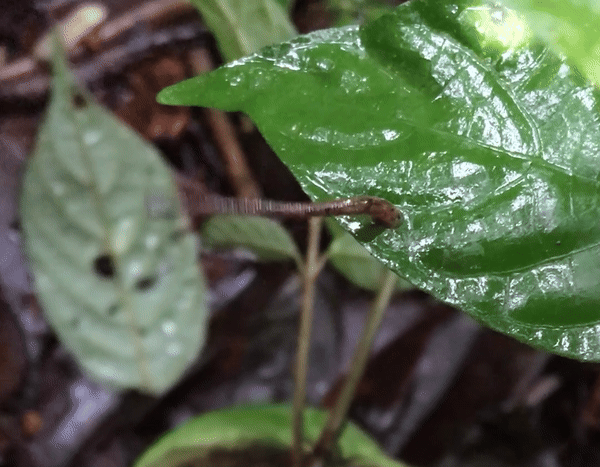Watch Blood-Sucking Leeches Leap From Leaves and Soar Through the Air
New videos may help settle scientists’ long-standing debate over whether leeches can jump

For centuries, observers have told tales of leeches leaping through the air in pursuit of their next meal—with written records of the creatures’ gravity-defying feats dating as far back as the 14th century. Ibn Battuta, a medieval Muslim traveler, described seeing the “flying leech” while visiting what is today Sri Lanka in the 1300s.
“It is found on the trees and weeds near the water and leaps to the person who happens to pass it,” he wrote.
But scientists have remained skeptical, even debating the mechanics of what a “jump” for a leech would really entail. Maybe land-dwelling leeches weren’t technically jumping, but rather, they were falling onto their victims from an overhead perch?
Now, for the first time, researchers have captured the behavior on video. They describe their observations of at least one species of leech jumping in a new paper published Thursday in the journal Biotropica.
Study co-author Mai Fahmy, a conservation biologist at Fordham University and a visiting scientist at the American Museum of Natural History, was in Madagascar in 2017 when she spotted a leech on a leaf. On a whim, she whipped out her phone and began recording. To her surprise, the skinny, wormy creature scrunched up the lower half of its body, then leapt onto the forest floor.
“I assumed this behavior was well documented,” she tells Scientific American’s Gennaro Tomma. “When I returned to the U.S. and showed [it to] my colleagues, I quickly realized this wasn’t the case.”
Then, in 2023, while visiting Madagascar again, Fahmy decided to film a pair of leeches on a leaf. Within a few seconds of pressing the record button on her phone’s camera, the leeches were once again hurtling themselves through the air.
“For each jump, the leech coils back before taking off,” Fahmy and her co-author Michael Tessler write in the paper. “Visually, this appears somewhat like a backbending cobra or a spring being pulled back to maximize potential energy.”
The leeches are far from graceful, especially when it comes to sticking the landing. But they don’t really need to be coordinated: Because they’re so light, they can pretty much land anywhere without getting hurt, reports the New York Times’ Veronique Greenwood.
Their technique resembles how other, similarly shaped creatures manage to jump, such as caterpillars and fly larvae.
The leeches in both videos belong to a species called Chtonobdella fallax. The serendipitous nature of Fahmy’s encounters suggests that jumping may be a common behavior for at least this species. In the future, scientists might be able to document other leaping leech species, too.
“We do not know how often this may happen … but, given that we caught multiple jumps in two short recordings, this behavior may be common for this species,” says Tessler, a biologist at the City University of New York and a research associate at the American Museum of Natural History, in a statement.
Scientists have identified more than 700 species of leeches, some of which live on land and some that primarily inhabit water. These segmented worms—which can grow from about half an inch to 8 inches in length and sometimes stretch to 17 inches—insert their proboscis into their host’s skin to suck its blood. They’re indiscriminate feeders, chowing down on fish, birds, amphibians and mammals, including humans.
One open question is whether leeches use their jumping powers to latch onto hosts specifically. If future research shows they do, those findings could help with conservation.
“Scientists searching leech guts to unravel which animals they’ve fed on may interpret their findings differently if the slippery bloodsuckers can soar, painting a more accurate picture of animal communities in the creatures’ Indo-Pacific homes,” writes Science’s Sean Cummings.
But not everyone is convinced the videos actually show “jumping,” a form of locomotion that researchers have a difficult time defining. So, despite what the co-authors describe as “conclusive evidence” of leeches springing from leaves, the debate may not be over just yet.
Sheila Patek, a biologist at Duke University who was not involved in the research, tells Science News’ Susan Milius the behavior looks like “something in between falling, controlled aerial descent and directed launch.”
“I honestly cannot tell whether that’s a jump or not,” she adds.
/https://tf-cmsv2-smithsonianmag-media.s3.amazonaws.com/accounts/headshot/SarahKuta.png)


/https://tf-cmsv2-smithsonianmag-media.s3.amazonaws.com/accounts/headshot/SarahKuta.png)